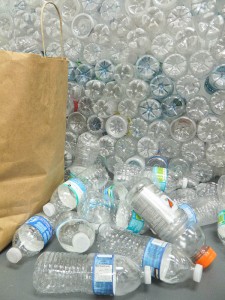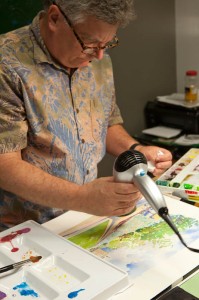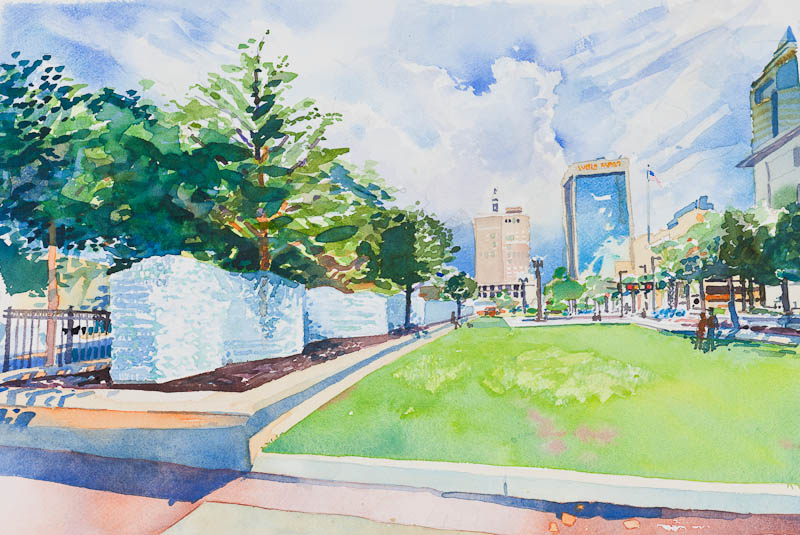 Next week I’ll be working on a 10 ft trial section of the wall and need about 2000 bottles. I’ve got about 200 now, so it’s off to the recycle bins and asking friends to save them. We stopped by the ballpark to check out the receptacles and didn’t feel like going through the trash to retrieve a bottle. Yuk! We’ll visit a road race over at Town Center tomorrow and the recycle bin at Mandarin Middle school. It’s amazing how many bottles get used everyday.
Next week I’ll be working on a 10 ft trial section of the wall and need about 2000 bottles. I’ve got about 200 now, so it’s off to the recycle bins and asking friends to save them. We stopped by the ballpark to check out the receptacles and didn’t feel like going through the trash to retrieve a bottle. Yuk! We’ll visit a road race over at Town Center tomorrow and the recycle bin at Mandarin Middle school. It’s amazing how many bottles get used everyday.
I happy to announce that Advanced Disposal has donated 50 corrugated event boxes and lids to hold the collection bags. Thanks Katrine for supporting our project!

The website now has some content, menus, and preliminary information. I also started to load the blog with notes from the beginning of the project. It’s easy to get carried away with this but if the project goes, the historical stuff is always fun to read.
The model of the planter is complete. It’s actually 8″ too small but still over 15 ft long. I figured no one will know (except all of you!). Tomorrow I’ll start cutting straws and building a section of the wall. I’d like to also have a placeholder for the trees, should be easy to find some dead branches around my house since I’ve be ignoring my yard for months.
A week ago I dropped off a note today to my neighbors to save water bottles for me to pick up. There is a lot to learn about water bottles, and the best way is to get a bunch. I managed to collect about 160 bottles and here are a few lessons learned:
- When you say you’ll accept a rinsed out non-water bottle, people will ignore you.
- Not everyone know what it means to keep the cap on.
- The labels on water bottles are attached with space-age adhesive, that once exposed, adheres to everything, including plastic trash bags, your fingers, and dirt. This adhesive is more tenacious than silicone caulk.
- Bottles are like people, they come in all shapes and sizes. Smooth, rough, skinny, big, light, heavy, sticky, noisy, empty, and full of it.
- Leaving bottles in a hot car, then bringing them into a cool space, will cause the bottle to collapse.
- Taking a bottle from a cool space to bake in the Florida sun will cause it to blow up like a balloon.
- It is impossible to “dry” the inside of a bottle without considerable effort.
- If you try to carry more than 10 bottles they will suddenly jump out of your hands and scurry to every corner of the room.
Today I purchased the domain messageinabottlejax.com and started creating the site using WordPress. Initially people will be coming to the site to see what this project is all about. We will be promoting the project and trying to get some support, and the site needs to explain what we are doing, why, and how. It also needs to give some specific instructions to those who have bottles to contribute, and those who want to help.
Another big aspect of the site is to allow our servicemen/women to see our message. In fact, I think this should be the primary purpose. So I’ve arranged to have the word cloud with the portrayal of the words people are writing as the main focal point of the page, and then pictures of the Wall of Light below. Since the wall doesn’t exist yet, we will feature an artist rendering (provided by Robert Leedy) and a mockup. We will also display the number of bottles we have collected so far.
This blog will be an important aspect of the project and hopefully will contain all the latest news about events and our progress.
Did you know there was an online caulk usage calculator?
Each bottle in the wall will have 6 touch points to adjacent bottles (2 top, 2 bottom, 2 sides), so each bottle will have 3 points for caulk application. Assume a ¼” dab per point, which I think is generous. A 10.3 oz tube of caulk with a ¼” bead will cover 24.4 feet (according to the caulk usage calculator).
24.4 x 12 / (3 x .25) = 390 bottles (say 350) per tube
A tube of silicone caulk is about $4.50
For 20,000 bottles, 57 tubes = $256
For 200,000 bottles, 570 tubes = $2,565 (ouch)
This morning I dropped by Lowe’s to pick up caulk (a tube of the cheapest white stuff and a tube of silicone) and a caulk gun. Time to glue some bottles together. Silicone definitely works best. The white stuff is watery and just doesn’t hold, even after drying. The silicone isn’t permanent though. You can still tear it apart. I don’t think there is a solvent available that can glue polyethylene. In fact super glue comes in polyethylene bottles.
Part of my advisory group met today to discuss next steps and the overall deadlines for the project. It was agreed that I needed to be further along on the wall proof of concept and construction details before we announced anything. I think everyone is timid about a potential pile of scrap bottles they would be associated with. Right now I’m trusting my instincts. Not everything can be worked out in detail. We have a LOT of work to do and I came to the conclusion that it is up to me to get this project going. Dorian (my lovely wife) agreed to be the Project Manager, which is a great relief because I know she will get the job done. I will do my best to focus on the structure and overseeing the overall direction.
My next steps are to refine the wall’s design, build the website, and develop strategies for support. If we can tie in some key players early, starting with the Mayor’s office, we can move through the schools, the military bases, and churches. In order to do the initial promotion, the concepts need to be solid.
My other realization is that this project needs to be grass roots, not something promoting a business or particular agenda. True, it is an arts project, but it is more importantly an expression of gratitude to the military, from me and the city. I want there to be no question about this.
 Artist Robert Leedy created this visualization of the Wall of Light. Robert is my studio-mate and a fantastic artist. He took my description and painted this. I’m not sure what the details of the wall will be, but I think Robert captured the presence of the wall in the park. Thanks Robert for lending your talents to the project. We’ll see how close you got.
Artist Robert Leedy created this visualization of the Wall of Light. Robert is my studio-mate and a fantastic artist. He took my description and painted this. I’m not sure what the details of the wall will be, but I think Robert captured the presence of the wall in the park. Thanks Robert for lending your talents to the project. We’ll see how close you got.

What will the wall look like? What shape or form will it take? Will its form be dictated by construction? How will light, both during the day and at night, affect the way the wall looks?
Good questions. The wall needs to represent more than a mass of recycled bottles. It needs to express the messages inside, and communicate the collective voice of everyone who contributed a piece of it. In order to arrive at a design for the wall, I am preparing a scale study model so that I can examine and evaluate different arrangements. To represent a bottle, I will use a plastic drinking straw. I found a case of them at Costco, 3,000 for $12. A typical water bottle is 2.5″ in diameter x 8″. The drinking straws were 3/16″ in diameter, which means they need to be cut into 0.6″ segments to match the proportions of a bottle. I can get 12 segments from each straw, which means I can model 36,000 bottles.
The planter in Main Street Park where the wall will be constructed is 210′ long and 18′ wide. In order to maintain the scale of the bottles to the straws (which is 13.33:1), the planter needs to be 189″ long (that’s 15′-9″) and 17″ wide. Now that’s a big model! I have some cardboard boxes that I rescued from the furniture movers and some foamcore…onwards with the model.
Seth Godin of the Domino Project recently sent out a request to purchase a book End Malaria. It is a book about doing great work PLUS a majority of the proceeds goes to Malaria No More. I received my copy today and found this quote from Michael Stanier, the editor of the book:
“Don’t undertake a project unless it is manifestly
important and nearly impossible.”
I was encouraged.

